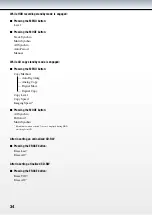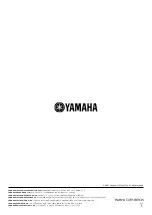
Glossary
AAC
An audio compression system conforming to the MPEG
(Moving Picture Experts Group) movie standard, offering
good quality at a higher compression ratio than MP3
compression.
CD TEXT
Text information recorded onto a CD, such as title, artist
name, lyrics, etc. You need to use a CD player/CD-ROM
drive corresponding to CD TEXT format.
Coaxial/Optical Digital Jacks
The digital input/output jacks. Any data input/output through
these jacks is free from degradation since the data sent
remains in the digital domain.
Coaxial/Optical connectors and cables differ physically, but
their function is the same.
Digital Move
Moves digital data on the HDD to a CD. The digital data
is deleted from the source HDD, or “moved.” This makes
it possible to copy between two generations, from CD to
HDD, and HDD to CD-R/RW, which is otherwise prohibited
by SCMS.
Emphasis
A recording mode used to improve audio quality, which
boosts high frequencies during recording, and then reduces
them proportionately on playback, resulting in decreased
hiss.
Format
Allows recording media like CD to be used on a specific
device, by conforming to the data writing system of the
device.
Before using an HDD, you will need to format it with your
CDR-HD1500.
Master and Slave
The main start-up disk for PC is called “Master,” while sub-
disks to be controlled are called “Slaves.”
The HDD connected to the CDR-HD1500 MUST be set to
“Slave.”
OSD (On Screen Display)
Shows the groups and/or tracks stored on the CDR-HD1500
on an externally-connected monitor for easier viewing.
For more information, see page 27 in the Owner’s Manual.
■
■
■
■
■
■
■
■
OPC
Abbreviation for ‘Optimum Power Control.’ The laser power
necessary used to write data varies depending on the CD-R/RW
selected. OPC allows the CDR-HD1500 to automatically adjust
laser power according to the CD-R/RW you use.
PCM
Abbreviation for ‘Pulse Code Modulation,’ which is an analog-
digital converter system to change analog audio data to digital.
The PCM system is employed for music CDs (CD-DA).
RS-232C
A serial transmission connector standard to allow a PC to
connect to peripheral devices such as a printer, monitor,
scanner, etc. A null modem (cross wire RS-232C) cable is
required to connect your CDR-HD1500 to the PC.
S Video/Composite Video Signals
S Video signals are transmitted with brightness (Y) signals
and chrominance signals separated. Composite video
signals, on the other hand, are transmitted with both signals
combined. Because its brightness and chrominance signals
are carried separately, S Video produces clearer images than
Composite video.
SCMS
Abbreviation for ‘Serial Copy Management System,’ which
prevents unlimited digital copies of commercial CDs,
allowing for ‘first generation’ copies only.
Sampling Frequency
To convert analog audio signals to digital, analog data
requires to be “digitized” periodically. This “digitization” is
called “sampling” and its frequency - the number of digital
‘bits’ per second - is called the “sampling frequency,” which
is measured in ‘Hertz’ (or simply ‘Hz’).
TOC
Acronym for ‘Table Of Contents,’ which contains a list of
the recorded tracks, session information, and CD-TEXT.
By loading the table of contents, a CD player can display a
CD’s playback time, etc., and access target tracks faster.
Track Marker
A separator, which separates two consecutive songs. A
player such as the CDR-HD1500 recognizes the song start
point by finding the track marker, which is also used for
Track Search and Intro Scan functions. You can create a
track marker on this unit either automatically or manually.
■
■
■
■
■
■
■
■





































